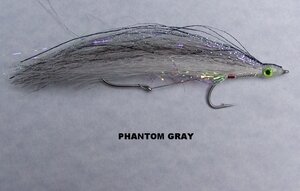
Phantom Gray Tandem Bucktailing Fly
Baitfish are camouflaged underwater and hard to see. This fly is a subtle pattern with just a bit of flash to give it away to feeding salmon.
Sold with an “Action Disc” for light tackle or fly rod salmon trolling.

Additional Info
Baitfish are naturally camouflaged in their environment. This pattern is designed not to gaudy and “In your face”. It is meant to be subtle with a hint of flash that will alert the searching predator. This is the most natural looking color scheme of my tandem salmon trolling flies.
TANDEM BUCKTAILING FLIES
These Tandem Bucktailing Flies are tied on a 1/0 stainless steel hook for durability. The barb can be crushed or the hook cut off at the bend if local regulations require. The trailing hook is a barb-less GAMAKATSU octopus, placed at the rear of the fly where king salmon tend to bite. I chose this hook for its quality and to have a true barb-less at the business end of this fly. The trailing hook is attached with a loop of stainless steel leader to allow for easy replacement. Depending on local regulations, anglers have used trebles and larger single hooks.
These flies are tied with synthetic materials rather than traditional bucktail. Natural bucktail is limited in length and becomes brittle with repeated soaking. By choosing synthetic materials, the service life of this fly is extended. Synthetic materials do not hold water allowing them to be cast with a fly rod. All of these patterns have flash to reflect light for the salmon to notice.
WHAT IS BUCKTAILING ?
Bucktailing is a specific technique of high speed trolling (2.5 to 4+ mph) where a bucktailing fly is pulled behind a boat just beyond the prop wash of the engine. The fly is at or just below the surface, often throwing a wake. The most common location for this technique is the outside edges of kelp beds where the water is 15 to 25 feet deep. Coho salmon feeding in and around kelp beds are attracted to the prop wash and will swim to the surface to hit the fly. With the fly only 15 to 30 feet behind the boat, the rod is pointed at the fly. Jarring strikes are the rule and it is an exciting way to fish. The prime season for this is in the Fall when the cohos have come in from the North Pacific feeding grounds and are heading toward their freshwater rivers.
These flies are not just for bucktailing, I have done well with them, trolling in a conventional sense. For light tackle trolling I recommend a Wiggle Fin Action Disc rather than a dodger or flasher.
